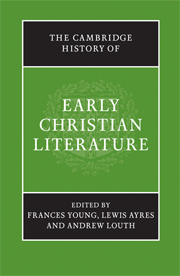Book contents
- Frontmatter
- PART ONE The Beginnings: The New Testament to Irenaeus
- PART TWO THE THIRD CENTURY
- PART THREE FOUNDATION OF A NEW CULTURE: FROM DIOCLETIAN TO CYRIL
- A LITERARY GUIDE
- B CONTEXT AND INTERPRETATION
- 37 Social and historical setting
- 38 Articulating identity
- 39 Christian teaching
- 40 Retrospect: interpretation and appropriation
- Bibliographies
- Index
- Map: The Roman Empire in the late fourth century AD"
- References
38 - Articulating identity
from B - CONTEXT AND INTERPRETATION
Published online by Cambridge University Press: 28 March 2008
- Frontmatter
- PART ONE The Beginnings: The New Testament to Irenaeus
- PART TWO THE THIRD CENTURY
- PART THREE FOUNDATION OF A NEW CULTURE: FROM DIOCLETIAN TO CYRIL
- A LITERARY GUIDE
- B CONTEXT AND INTERPRETATION
- 37 Social and historical setting
- 38 Articulating identity
- 39 Christian teaching
- 40 Retrospect: interpretation and appropriation
- Bibliographies
- Index
- Map: The Roman Empire in the late fourth century AD"
- References
Summary
The purpose of this chapter is to explore some of the ways in which Christian belief and hence some key aspects of Christian identity were articulated and formed from around AD 300 to 451. This subject has far too many facets to be covered in just one chapter. This is especially so in the light of the many different approaches used in contemporary early Christian studies to consider the formation and nature of Christian identify. In this chapter, however, my focus will be fairly narrow: I will primarily consider how the various doctrinal disputes of the fourth and early fifth centuries unfolded and how they led to the development of a particular account of ‘orthodox’ belief as it is represented in the writings of Christians towards the end of this period. One might conceive of this exercise as exploring how some key aspects of the late antique Christian imagination were shaped through internal and external dispute.
At the turn of the fourth century two of the most important issues facing the Christian community were the place of Christianity in the Roman Empire and the nature of the Church as a unified body (both in terms of organization and teaching). The legitimization of Christianity did not suddenly effect a shift from a pluralistic Church that saw itself as clearly ‘apart’ from worldly authority and structure to a more monolithic body that was immediately willing to accommodate itself to and desire worldly power, as some older, mostly Protestant, narratives suggested. At the turn of the fourth century Christians already had a long history of ad hoc alliances with the Roman authorities, and we know of previous instances where Christians had attempted to involve those authorities in internal disputes.
- Type
- Chapter
- Information
- The Cambridge History of Early Christian Literature , pp. 414 - 463Publisher: Cambridge University PressPrint publication year: 2004
References
- 1
- Cited by



